Nebraska has oranges? Well, no, not really. But, sort of.
Osage orange isn’t an orange though it may look like a bright yellow to yellow-green, grapefruit-sized, brainy-looking type of orange fruit. It is a fruit of the Osage orange tree, that is. However, the tree is more closely related to the mulberry tree. Enter its primary nicknames; hedge apple, hedge ball, and mock orange.

Confused? A bit perplexed, are you?
Allow me to continue.
I bet you’ve seen these wrinkled, softball-sized spheres on sale at your local grocery store, supermarket, farmer’s market or garden center.
Perhaps you have caught a glimpse of these scattered about the ground along the edge of an old shelter belt, windbreak or fence line while hunting or hiking?
Whatever the scenario may be, look closely at the fruit of the Osage orange. Strange, isn’t it?
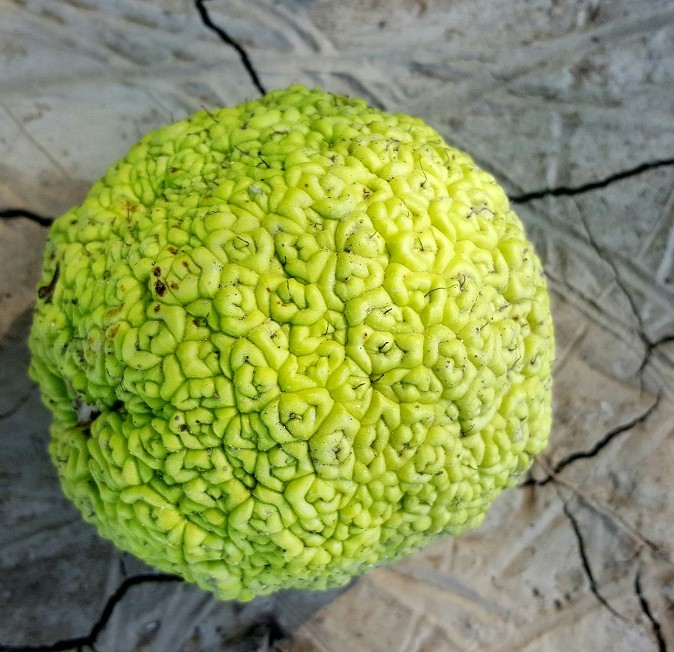
But, what exactly is it? Where does it grow? Is it native to Nebraska, or how did it get here? Is it really good for anything? Is it a decent bug repellent?
The Tree
The Osage orange tree (Maclura pomifera) is a member of the Mulberry or Moraceae Family. It has a number of other common plant names such as bodark, bodock, bois d’arc, bowwood, naranjo chino, mock orange, monkey brain, hedge apple, hedge ball, yellow-wood, Osage apple and horse apple.
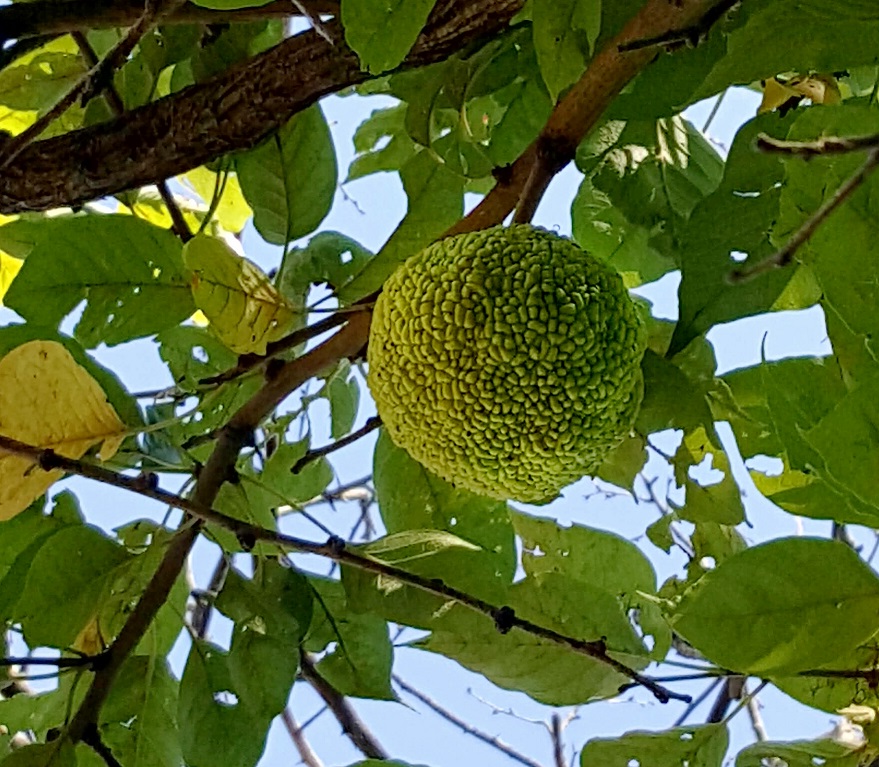
It is a small- to medium-sized deciduous tree that commonly grows about 30 to 40 feet tall, but may go higher. The tree has a short trunk and a rounded, irregularly-shaped crown. The leaves of the Osage orange are a shiny medium to dark green and turn yellow in the fall. The twigs are buff to orange-brown and are armed with 1/2-inch long sharp spines. Growing the hardy Osage orange trees is not difficult since the they grow readily from both seeds and cuttings. The Osage orange makes a decent shade tree in about ten years.
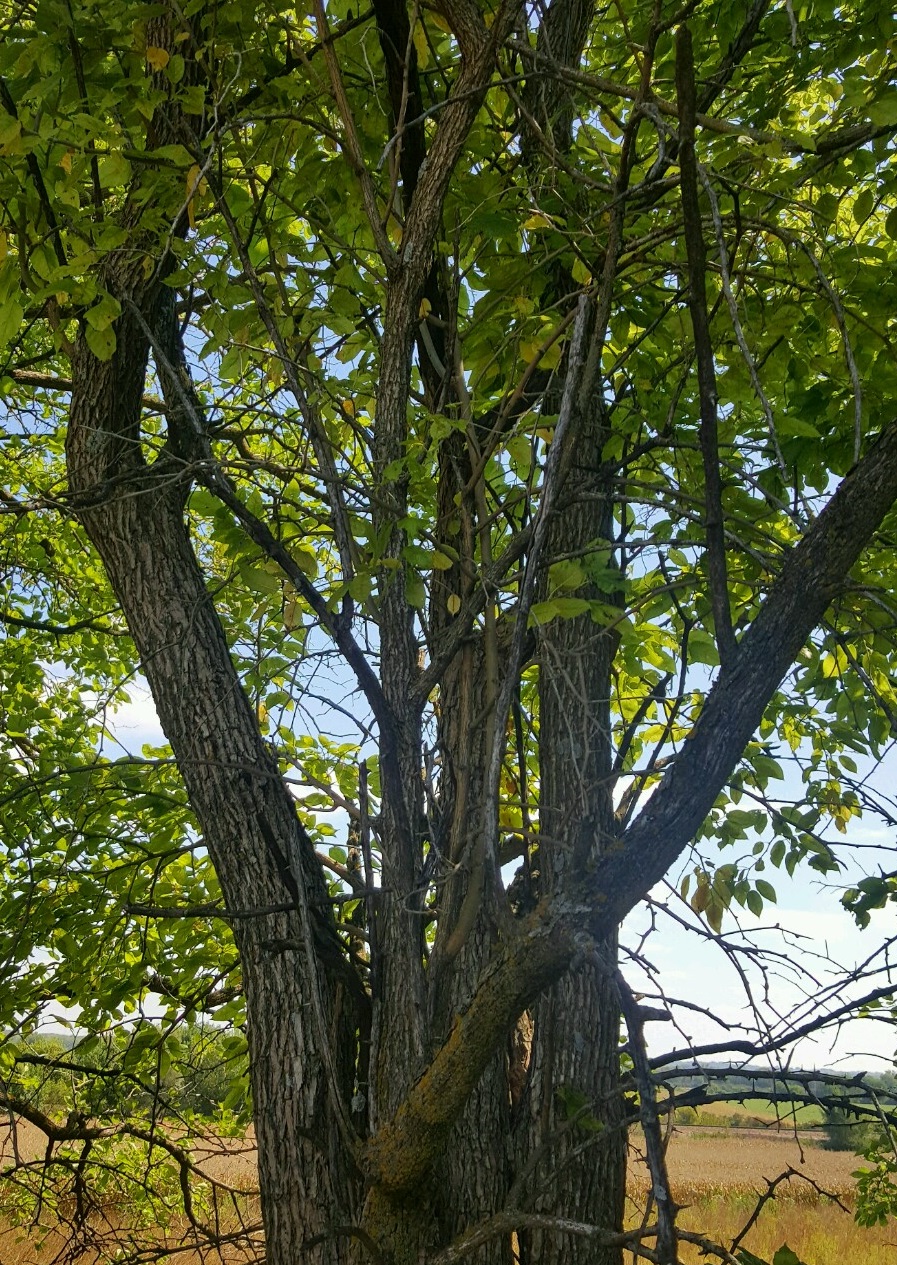
This tree provides good nesting habitat and shelter for certain wildlife. Small mammals and
birds use the thorny tree for protective cover.
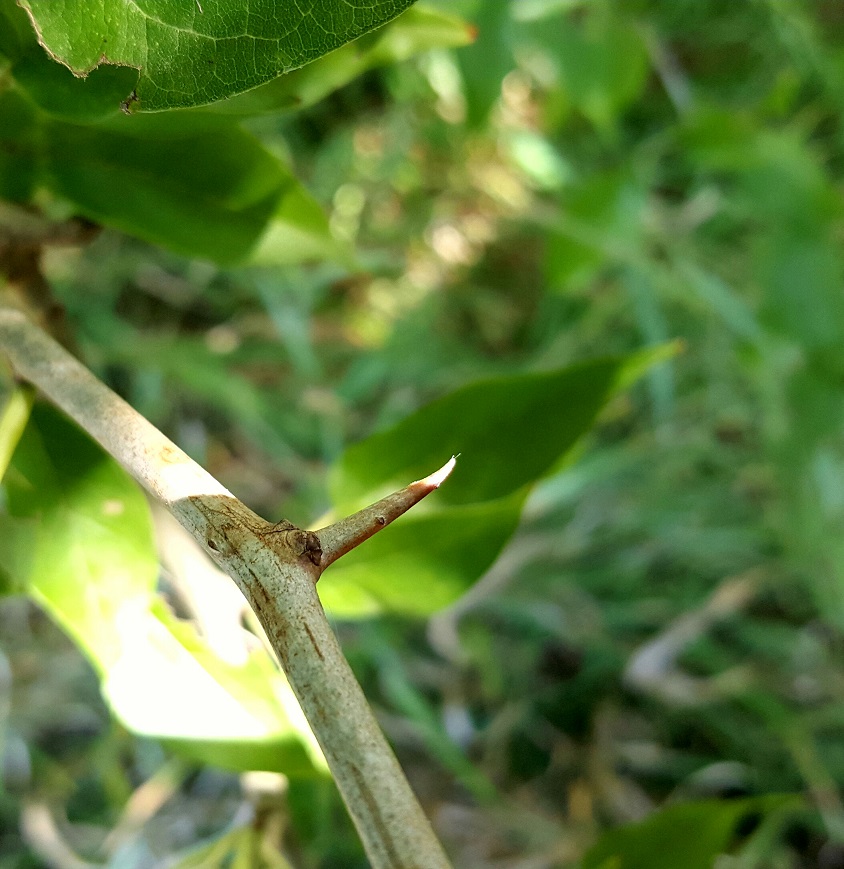
The stems and fruit of the Osage orange exude a milky, latex-like sap when cut that can cause irritation to the skin. This sap has been used to make glue and lacquer.
The Osage orange is what we call dioecious, meaning that male and female flowers are produced on separate trees. The small, green flowers appear in May or June.
The female trees produce 4- to 6- inch-diameter fruit which ripen in September or October and fall to the ground. The “hedge apple” or “mock orange” is an aggregate fruit composed of numerous one-seeded druplets.
The History
Named after the Osage Native American tribe which lived near the home range of the tree, and the aroma of the fruit after it is ripe, the Osage orange originally came from the southwestern United States, in a relatively small area of western Arkansas, southern Oklahoma and parts of east Texas. It was from the branch wood of the Osage orange tree that the tribe constructed their highly prized bows. Tribal members had other uses for the Osage orange as well. The stout wood was ideal for war clubs and tomahawk handles. The ridged and scaly bark of the trunk offered both a fiber for rope and tannin for making leather. Root tea was used to wash sore or inflamed eyes. The roots and inner bark were used to make a light orange-yellow dye. Early pioneers adopted this dye for their homespun cloth and later it was used commercially to color the American forces’ olive drab uniforms during World War I.
And, it was a curiosity when Meriwether Lewis sent some slips and cuttings of Osage orange to President Jefferson in March of 1804. As early as 1806 President Thomas Jefferson referred to the Osage orange in a message to Congress. He had heard information from British explorers of the Arkansas country about the tree’s potential as a hedge plant, a potential soon to be realized.
The Osage orange is now considered to be “naturalized” throughout much of the eastern and central regions of the U.S. The University of Nebraska-Lincoln’s Institute of Agriculture and Natural Resources lists the Osage orange as an invasive species. That’s because the Osage orange has the potential to invade areas abused by poor management and the overgrazing of pasture and rangeland.
The Osage orange’s reputation for tolerating just about any environmental stress thrown its way is likely the reason it was so popular on farmsteads as a hedge addition. Prairie settlers learned that it was easy to transplant, fast-growing, tolerated a wide range of soils, extreme heat and strong winds and had no serious insect or disease problems. Armed with wicked thorns, they found it was an ideal hedge plant from a security standpoint for their livestock.
During the mid-nineteenth century, Osage orange trees were widely planted by Midwest farmers as a living fence. When pruned into a hedge, it further provided an impenetrable barrier to hogs, cattle, sheep and even horses. According to the National Park Service, at Homestead National Monument, in ca. (circa) 1875-1885, Daniel Freeman planted a three-quarter mile long, Osage orange (Maclura pomifera) hedgerow along the southern boundary of his farm. Besides marking Freeman’s property boundaries and conserving his timber resources, the hedge may have served as windbreak.
But the wide spread planting of Osage orange stopped with the introduction of barbed wire. Since that time, many of the original hedges have been destroyed or died. In Nebraska, Osage orange trees remain in various places along old fence lines, windbreaks, pastures, shelter belts and ravines. Landowners with Osage orange trees still in hedgerows continue to benefit with increased crop yields from wind protected fields.
The wood of this species is hard, heavy, durable, naturally rot-resistant and somewhat flexible. It has been used to make wagon wheel hubs and rims, archery bows, tool handles, musical instruments, furniture, decks and fence posts. Some Osage orange fence posts set more than 70 years ago are still standing strong!

Archers actually consider the wood of the Osage orange to be the world’s finest wood for bows. No doubt, some of the first telegraph messages sent west pulsed across parts of the Midwest on wires held aloft on Osage orange poles. Today, artisans use Osage orange wood to make everything from custom furniture to high quality game calls.
Also, a bright yellow dye can be extracted from the wood.
The split wood of Osage orange is rather easily lit and turns to an orange tint in a fire. Interestingly, University of Nebraska-Lincoln researchers have found that dried Osage orange or “hedge” is highest in BTU’s of dried wood from native trees when used as firewood. However, burning the wood results in considerable sparking.
The Fruit
The fruit of the wild Osage orange is rather fascinating.
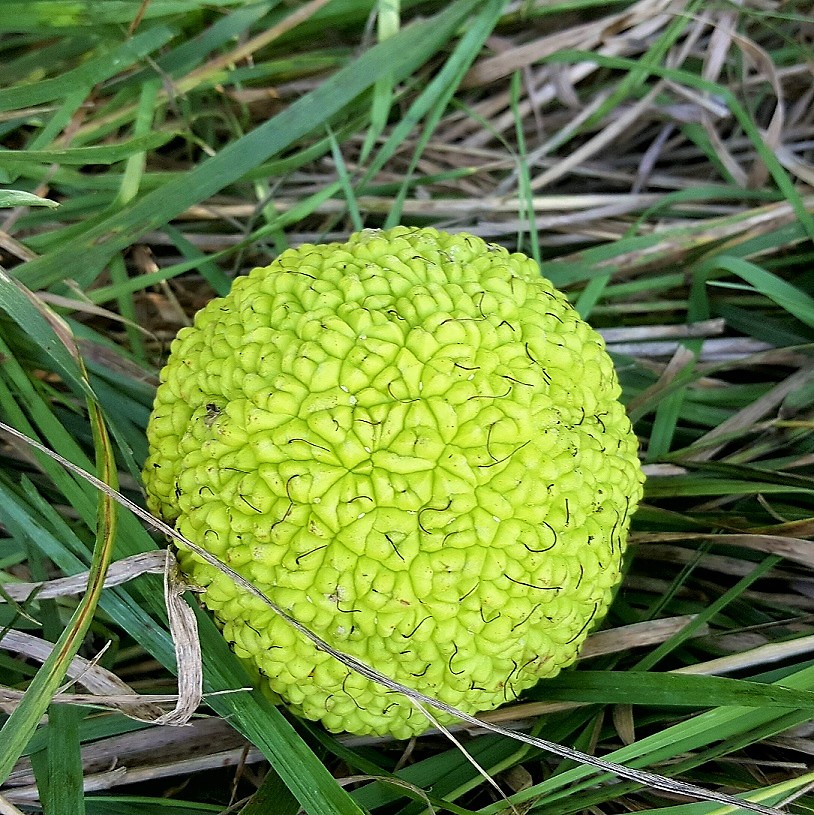
Vividly yellow to yellowish-green in color, the Osage orange fruit has a fruity, citric fragrance and is inedible to humans, even though naturalists say the seeds are edible. They supposedly taste somewhat like raw sunflower seeds but take a lot of work to get.
Hedge apples or mock oranges are not an important source of food for wildlife as most birds and animals find the bitter-tasting, fleshy fruit unpalatable. The two main exceptions are the fox squirrel and white-tailed deer. Fox squirrels will shred the fruit to get those oblong seeds it wants to eat. White-tailed deer have been known to sniff, lick and eat the fruit. But other animals like the red fox, red crossbill, downy woodpecker and northern bobwhite quail occasionally eat the seeds.
While the fruit of the Osage orange has been suspected of being poisonous to livestock, studies conducted in several states have been negative and disprove that. However, it may cause death in ruminating animals like cows by lodging in the esophagus and preventing the release of gases.
The belief about the use of the mock oranges for insect and spider control is widespread but has been dispelled as a myth by experts.
The claim is that by placing hedge apples, whole or sliced, around the foundation of a house, inside a basement or garage or in drawers or cupboards, that they will repel or control insects and spiders.
Several years ago, Iowa State University toxicologists extracted compounds from hedge apples. When concentrated, these compounds were found to repel insects. However, the scientists also discovered that natural concentrations of these compounds in the fruit were too low to be an effective repellent.
Furthermore, the University of Minnesota Extension Service indicates the essential oil of Osage “oranges” is a repellent to German cockroaches, but this “doesn’t explain why using whole, intact Osage orange fruits would control spiders and insects.”
So, if they don’t repel insects and spiders, why do people buy them? Tim Smith, former botanist for the Missouri Department of Conservation, says it’s because these fragrant, sticky fruits appear about the same time spiders and insects are on the decline. He points out that this decrease happens anyway as colder fall and winter temperatures arrive, and heated houses provide a less humid environment for bugs.
Also, if folklore were accurate, Osage orange would be virtually free of insects in nature, right? However, studies show that up to 54 arthropod species have been found feeding on Osage oranges!
But these big, impressive fruits must be good for something beyond target practice in the fall, right? Yes.
They’re bright, textured and aromatic, and they can look and smell awfully nice in a seasonal arrangement in the entry way of your home or on your dinner table.

Seasonal arrangement featuring Osage orange fruit or hedge apples. Photo by Greg Wagner/Nebraska Game and Parks Commission.
My wife puts them in bowls and baskets sometimes with other fresh fall produce and foliage in our kitchen.

A friend says you can also slice them, dry and use them in other craft-like projects.
So, on your next fall hike, carry a basket, pail or sturdy sack and collect some. Before gathering, be sure to get landowner permission, watch for poison ivy and observe caution around the trees because of their thorns and possible falling fruits on blustery days. Rubber or latex gloves are also suggested to be worn due to the sticky, white juice in the fruit that can be an irritant to the skin.
Be careful, and have fun gathering Nebraska oranges!

The post Nebraska Oranges appeared first on Nebraskaland Magazine.
















